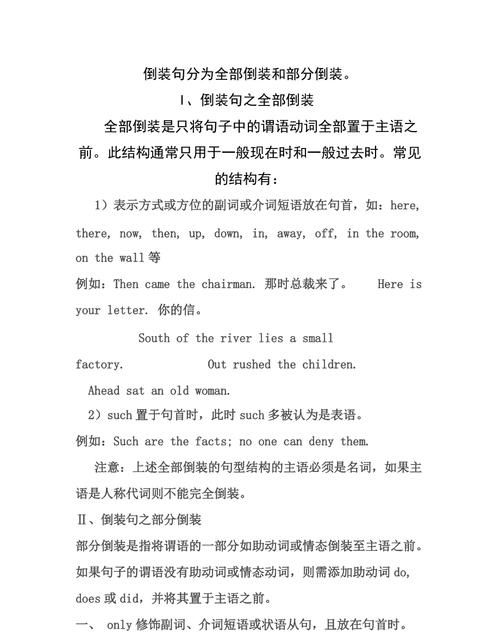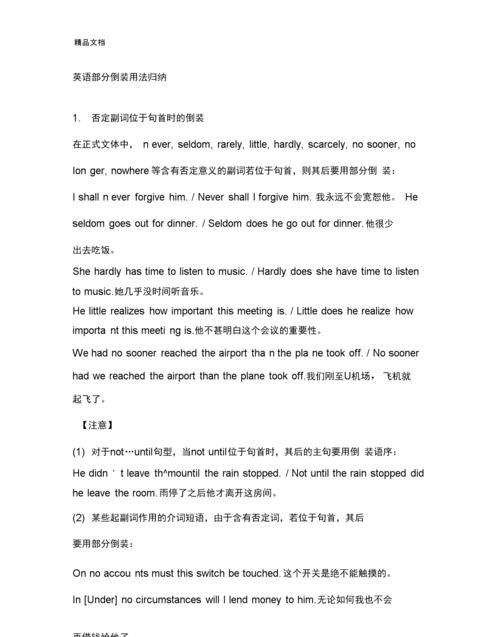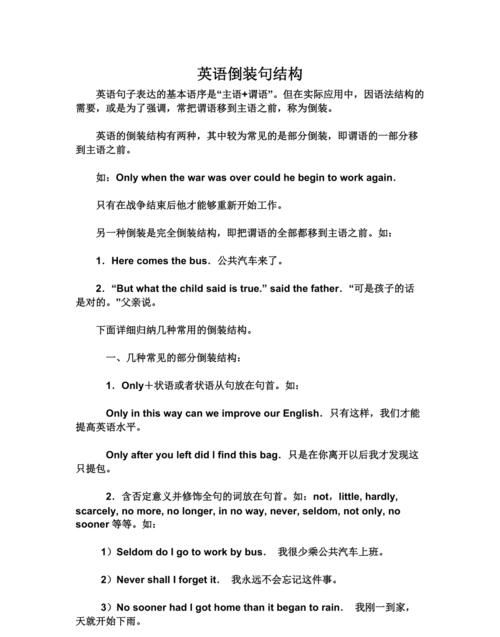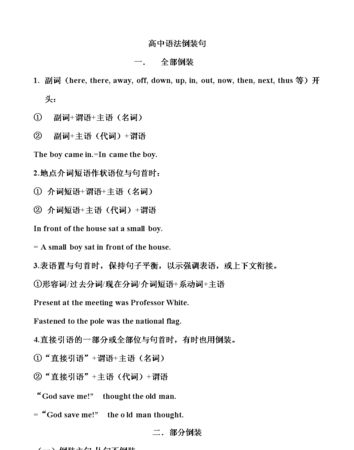本文目录
高中英语倒装句的用法归纳
高中英语倒装句常见结构和用法的介绍
1完全倒装结构及用法
一、具有“地点”意义的副词、时间意义的副词,以及能表移动方向的副词放在句首,句子的主语是名词,谓语是连系动词或表示“位置移动”的单个不及物动词时,该动词放在主语前面。如:There goes the bell.
注意:当主语是人称代词时,尽管副词在句首,主谓不倒装。如:Out they rushed.
二、具有“方位”意义的介词短语或副词短语在句中作状语或表语放在句首,谓语是连系动词be,以及表示“位于、存在”或“位置移动”的单个不及物动词时,该动词放在主语前面。如:Among the hens is a big cock.
三、作表语的形容词或分词放在句首时,连系动词放在主语前面[英语语法]。如:Present at the party were the ladies in the big city.
四、全部倒装是只将句子中的谓语动词全部置于主语之前。全部倒装常见结构有:
1) here, there, now, then, thus等副词置于句首, 谓语动词常用be, come, go, lie, run。
There goes the bell.
Then came the chairman.
Here is your letter.
2) 表示运动方向的副词或地点状语置于句首,谓语表示运动的动词。
Out rushed a missile from under the bomber.
Ahead sat an old woman.
注意:上述全部倒装的句型结构的主语必须是名词,如果主语是人称代词则不能完全倒装。
Here he comes. Away they went.
2部分倒装结构及用法
把谓语的助动词、情态动词放在主语前面为部分倒装。在下列情形中出现部分倒装。
一、把“so ... that ...”句型中的“so + 形容词 / 副词”部分放在句首时,be动词或助动词放在主语前面。如:
So frightened was the girl that she daren't move an inch further.
二、用so,neither或nor构成的特殊句型,表示另一人或物也具有和前面提到的同样情况时,出现部分倒装。如:
Jim asked the question. So did Lily.
三、把具有“否定”意义的词语放在句首时,出现部分倒装。如:
Never shall I forget your advice.
四、注意下面几种情形的倒装:
1. “only + 状语从句”和“not until + 从句”位于句首时,在主句中进行倒装。如:
Not until the child slept did the mother leave the room.
2. “not only...but also...”连接两个分句,not only位于句首时,倒装在not only所在分句进行。如:
Not only were the children moved but also the adults showed their pity.
3. “no sooner...than...”句型中的no sooner位于句首时,倒装在no sooner 主句中进行;“hardly / scarcely...when...”句型中的hardly位于句首时,倒装在hardly / scarcely主句中进行。如:
No sooner had I gone in the house than it began to rain.
4. 当if引导从句表示虚拟语气时,if可省,再把从句中的were,had或should放在主语前面,形成部分倒装。如:
Had we been present, such a thing would not have happened.
5. 当as引导让步状语从句时,参照下面的形式进行特殊倒装。如:
Proud as these women are, they still look very weak. (作表语的形容词提前)
Student as he is, he often works in the factory. (作表语的名词提前,同时省去不定冠词a)
Hard as she worked, she couldn't support her family. (修饰谓语动词的副词提前)
Try as he would, he might fail again. (带助动词的谓语动词提前)
五、部分倒装是指将谓语的一部分如助动词或情态动词倒装至主语之前。没有助动词或情态动词,则需添加助动词do, does或did,并将其置于主语之前。
1)句首为否定或半否定的词语,如no, not, never, seldom, little, hardly, at no time, in no way, not until…,not only…(but also), hardly/scarcely…(when), no sooner…( than) 等。
Never have I seen such a performance.
Nowhere will you find the answer to this question.
Not until the child fell asleep did the mother leave the room.
Not only did he refuse the gift, he also severely criticized the sender.
Hardly had she gone out when a student came to visit her.
No sooner had she gone out than a student came to visit her.
2) so, either, nor作部分倒装
Tom can speak French. So can Jack.
If you won''t go, neither will I.
3) only在句首要倒装的情况
Only in this way, can you learn English well.
Only after being asked three times did he come to the meeting.
Only when he is seriously ill, does he ever stay in bed.
4) as, though引导的倒装句
as / though引导的让步从句必须将表语或状语提前 (形容词, 副词, 分词, 实义动词提前)。
Try hard as he will, he never seems able to do the work satisfactorily.
Young boy as he is, he knows a lot about basketball teams.
Hard as it was, they reached the peak of the mountain.
5) 其他部分倒装
1)so… that 句型中的so 位于句首时,需倒装。
So frightened was he that he did not dare to move an inch.
2)在某些表示祝愿的句型中:
May you all be happy.
3)在虚拟语气条件句中从句谓语动词有were, had, should等词,可将if 省略,把 were, had, should 移到主语之前,采取部分倒装。
Were I you, I would try it again.
常见考法 1. not until 引导时间状语(从句)时的倒装;
2. 含so 的句子倒装与不倒装的区别;
3. only引导状语或状语从句时的倒装;
4. 虚拟条件句省略If时的倒装。
误区提醒1) Not until the early years of the 19th century___ what heat is
A. man did know B. man knew C. didn''t man know D. did man know
解析:答案为D.否定词not在句首,要求用部分倒装的句子结构。
2) Do you know Tom bought a new car?
I don''t know, ___.
A. nor don''t I care B. nor do I care
C. I don''t care, neither D. I don''t care also
解析:答案为B.句中的nor引出部分倒装结构,表示"也不"。由 so, neither, nor引导的倒装句,表示前一情况的重复出现。其中, so用于肯定句, 而 neither, nor 用在否定句中。
3) --- You forgot your purse when you went out. --- Good heavens, ____ .
A. so did I B. so I did C. I did so D. I so did
解析:错选A。 本题空处不表跟前面情况一样,只是对上述情况的随声附和,所以不用倒装。正确答案B。
4)Only when the war was over ____ to hometown.
A. did the soldier return B. the soldier returned
C. returned the soldier D. the soldier did return
解析:only 引导状语或状语从句时主句要用部分倒装。此题为一般过去时,须在主语前加did, 故正确答案为A。
5) ____ for the free tickets, I would not have gone to see films so often.
A. If it is not B Were it not C. Had it not been D. If they were not
解析:错选A。此题关键是前后时态要呼应。本题是一个虚拟条件句,根据主句的时态,应该是对过去情况的虚拟,所以往前推一个时态的话,应该是过去完成时。故正确答案为C。

英语倒装句完全倒装和部分倒装的区别
1、倒装句主要分为完全倒装和部分倒装。
2、完全倒装:(全谓主):倒装词+v+主,人称和时态不变,语序变。遇到以下三种情况需要用完全倒装。(1)表地点的介词短语放句首,例:here/there;(2)表方位的adv放句首,例:up/down、in/out;(3)当较短的句子里的now和then放句首。
3、部分倒装:(助主谓),倒装词+一般疑问句,倒装在主句部分。(1)表否定意义的adv放句首,例:no,not……;(2)特殊句式放句首,hardly……when……no sooner……than……;(3)only+状语放句首,注意:only+主语不到装,例:Only you can solve the problem;(4)so……that……句型中的so放句首,注意:so后必须紧跟adj/adv。

高中英语倒装句讲解视频
高中英语倒装句的讲解
1.倒装句的定义:英语最基本的词序是主语在谓语动词的前面。
如果把谓语动词放在主语前面,就叫做倒装。
2. 倒装句的构成
a) 完全倒装
将句子的主语和谓语完全颠倒过来,称之为完全倒装。
Are you from here? 你是本地人吗?
Now comes the chance. 机会来了。
b) 部分倒装
只将助动词、系动词或情态动词移至主语之前,谓语的其他部分仍保留在主语的后面,称之为部分倒装。例如:
Has he come? 他来了吗?
Seldom have we felt as comfortable as here. 我们难得像在这里这么舒服。
Only in this way can we do the work better.
3. 倒装的原因
a) 句子语法结构的需要。例如:
Did you attend the meeting? 你参加会议了吗?
Long live peace! 和平万岁!
b) 一些句型的固定用法。例如:
Such were his last words. 他最后的话就是这样。
c)强调的需要。倒装以后,句子更加流畅生动。例如:
Never before have we seen such a sight. 以前我们从来没有见过这样的情景。
Before us lay a lot of difficulties. 在我们前面有很多困难。
Often did we warn them not to do so. 我们曾多次警告他们不要这样做。
4. 倒装句的基本用法
a) 构成疑问句(除对主语或主语之定语提问的特殊疑问句外):
When are we going to drink to your happiness? 我们什么时候喝你们的喜酒?
Have you seen the film? 你看了那部电影吗?
b) 在以here, there, now, then, in, away, up down
c) 副词only+状语放在句首时:
Only then did he realize his mistakes . 只有在那时他才认识到自己的错误。
Only in this way can you learn maths well . 只有用这种方法你才能学好数学。
d) 含有否定意义的副词或连词(如little, hardly, never, rarely, no soonerthan等)放在句首时:
Little did I think that he could be back alive. 我没有想到他竟能活着回来。
Not until New Years Day shall I give you a gift. 我要到元旦那天才能给你礼物。
Hardly had the train arrived at the station when we ran towards the sleeping car looking for our guests.
火车刚一进站,我们就跑到卧车那儿去找我们的客人。
e) 副词so或 neither(nor)在句首:
He is interested in pop-songs, and so am I.他对流行歌曲感兴趣,我也如此。
He hasnt been to the countryside, neither does he want to go there.他没有去过农村,他也不想去那里。
f) 在方式状语thus开头的句子中及程度状语so放句首:
Thus ended his life. 这样结束了他的生命。
So loudly did he speak that even people in the next room could hear him . 他讲话的声音那样大,连隔壁屋子里的人都听得见。
高二英语的语法的知识点
一、过去分词
过去分词兼有动词、副词和形容词的特征,可以带宾语或受状语修饰。过去分词和宾语或状语一起构成过去分词短语。它在句中可以作定语、表语、宾语补足语或状语。这节课讲解作定语、表语的用法。
1. 作定语
作定语的过去分词如果是单词,一般放在被修饰词的前面;过去分词短语作定语,一般放在被修饰词的后面。例如:
There are many fallen leaves on the ground.
This is a book written by a worker.
2. 作表语
过去分词作表语,多表示主语所处的状态。
I was pleased at the news.
The door remained locked.
过去分词作表语,相当于形容词,常见的有:
delighted, disappointed, astonished, interested, satisfied, surprised, tired, worried, excited, married 等。
过去分词作表语时,应注意与被动结构的区别。系表结构说明主语的状态或具有的性质、特点;被动结构强调谓语动作。
The small village is surrounded by trees.(状态)
The small village was soon surrounded by enemy soldiers.(动作)
I'm interested in chess.(状态)
3. 过去分词做状语
①表时间,相当于一个时间状语从句,有时过去分词前可加连词 when 或 while 来强调时间概念。
Seen from the top of the hill, the city looked like a big garden.
从山顶上看,这个城市就像一个大花园。
Accepted by the Party, he decided to devote his life to the cause of the Party.
入党以后,他决定献身于党的事业。
②表原因,相当于一个原因状语从句。
Exhausted, the children fell asleep at once.
由于太累了,孩子们马上就睡着了。
Encouraged by the speech, the young people made up their minds to take up the struggle.
受到了讲演的鼓舞,年轻人决定起来从事斗争。
③表条件,相当于一个条件状语从句,有时过去分词前可用 if 等词。
Heated, water changes into steam.
如果加热的话,水会变成水蒸气。
Given another chance, he will do better.
再给他一次机会,他会做得更好。
④表让步,相当于一个though/although引导的让步状语从句。
Laughed at by many people, he continued his study.
尽管被许多人嘲笑,他还是继续他的研究。
⑤表伴随,说明动作发生的背景或情况。
Surrounded by a group of pupils, the old teacher walked into the classroom.
被学生包围着,那位老教师走进了教室。
The trainer appeared, followed by five little dogs.
教练出现了,身后跟着五条狗。

高中英语倒装句用法总结
英语倒装句12种类型
2019-04-30 11:30:31
文/董玉莹
倒装句:英语最基本的语序是主语在前,谓语动词在后。但有时由于句子结构的需要或表示强调,就要采用倒装形式。

1完全倒装
1. 用于 there be 句型.
2. 用于“ here ( there, now, then )+不及物动词+主语”的句型中,或以 in, out, up, down, away 等副词开头的句子里,以表示强调.
注意:
( 1 )主语是代词时,主语和谓语不倒装.
( 2 ) here , there 放在句首通常用一般现在时.
3. 当句首状语为表示地点的介词词组.
4. 表语置于句首时,倒装结构为“表语+连系动词+主语”:
( 1 )形容词+连系动词+主语
Present at the meeting were Mr Li, Mr Wang and many other teachers.
出席会议的有李老师、王老师和其他很多老师.
( 2 )过去分词+连系动词+主语
Gone are the days when we used foreign oil.
我们使用洋油的日子一去不复返了.
( 3 )介词短语+ be +主语
Among the goods are books, exercise-books, pens and some other things.
在所有的货物中有书、练习册、钢笔和其他东西.
5. 用于 so, neither , nor 开头的句子,表示重复前句的部分内容.原句的谓语应与前句的谓语的时态、形式相一致.
例如:You can't speak French. Neither can she.
你不会说法语,她也不会.
6. 为了保持句子平衡,或为了强调表语或状语,或是上下文紧密衔接时.
例如: They arrived at a small village, in front of which was a big river.
他们来到一个小村庄,村庄前面是条大河.
2部分倒装
1. 否定副词位于句首时的倒装
在正式文体中,never, seldom, rarely, little, hardly, scarcely, no sooner, no longer, nowhere 等含有

以上就是关于高中英语续写部分倒装句,高中英语倒装句的用法归纳的全部内容,以及高中英语续写部分倒装句 的相关内容,希望能够帮到您。

